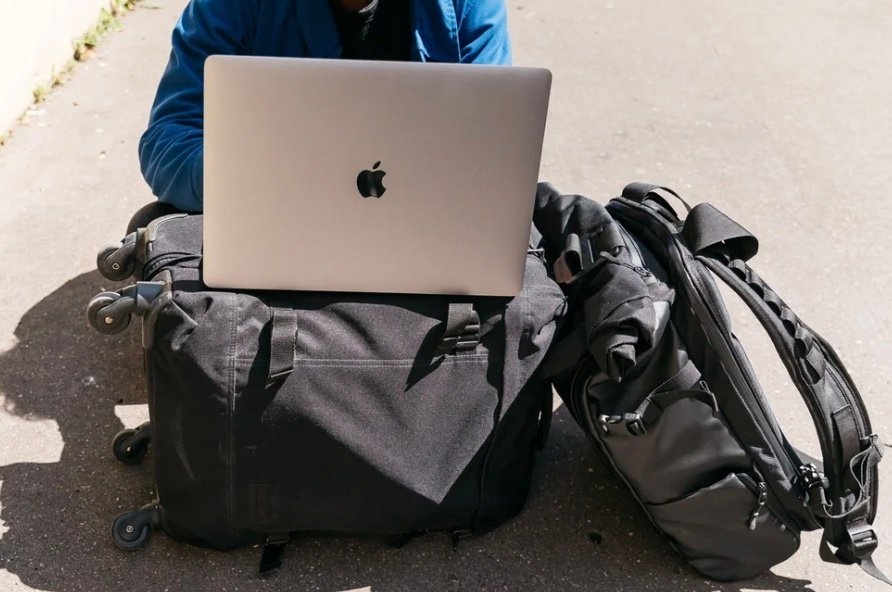The ultimate guide to becoming a digital nomad in 2025
Jun 28, 2023 - updated Nov 19, 2024
10 mins


US Editor at Welcome to the Jungle
Calling all modern-day adventurers and laptop warriors! Are you ready to break free from the office and embrace the lifestyle of a digital nomad? With the rise of remote work, the world has become a playground for those seeking new, flexible ways to live and work. More and more people are taking up the challenge too. A 2024 study on digital nomads from MBO Partners, a management and services consultancy, found that 18.1 million Americans describe themselves as digital nomads, a number that has been consistently on the rise since 2019.
But is it that easy to just up and leave? We might dream of sipping coconut water on the beach with our laptops in hand, but is it really as glamorous as our dreams would have us believe? And what questions should we ask before rejecting stability? To find out, Welcome to the Jungle spoke to two seasoned nomads and assessed the options. So before dusting off your passport and setting out across the world, let’s unpack the lifestyle and then look at the best destinations in 2025 for digital nomads.
The spirit of adventure
Some people find the standard nine-to-five routine ill-suited to their adventurous spirit. With the rise of remote work, their latent desire to explore the world while continuing to create has been awakened and actualized. One of these is Han Talbot, creative project manager and host of The Remote Life podcast. “I think I’ve always known that I was never really destined for a traditional nine-to-five office job,” says Talbot, whose background is in social media marketing. “I found that I was so much more productive when I was out of the office, working in a creative environment, in a more open space where I could just be me.”
The idea that she could travel without giving up working began to take root when she was in a role that demanded flexibility. “I was already doing a job in marketing where it required me to be flexible, living in London, going to different events, going to different meetings around the city,” she explains. This solidified her belief that she was productive outside conventional structures. “The more I did it, the more I realized that I was just so much more productive when I was allowed to have control and take a lead on how I work,” she says.
Her passion for travel has always been a significant part of her life. “I’ve always loved to travel. It just so happened that having a flexible work schedule means that I can do both what I love and do a job that I am flexible in as well,” she says.
Becoming a digital nomad is not only about escaping the confines of the traditional office but also about finding a work style that enhances productivity and creativity, according to Talbot. Nomads are free to travel and to work in whatever environment best suits their individual style.
A nomadic life also requires discipline and adaptability. Can you handle the instability of working from different locations, with different time zones, cultures, and people? Or would you prefer to find one exotic location in which to be based for a while?
Consider your true motivation
The lure of the lifestyle can be irresistible, but Talbot says it’s crucial to understand your motivation before taking action. “Many envision being a digital nomad as a never-ending holiday. This isn’t the reality. You must first understand what you desire from this location-independent lifestyle before it overwhelms you,” Talbot says. “Do you truly crave this lifestyle, or do you simply need a vacation?”
Talbot advises experimenting before committing. “Try out the lifestyle first. For me, I had already been working across different cities and was constantly on the go. I knew I could make being a digital nomad work because I was already living it,” she says.
Transitioning to this lifestyle involves more than just shifting your work location — it’s a major lifestyle change. Many factors come into play, including your work schedule, time zone, and even what you expect from a destination. Talbot advises taking short trips near your home first. “Try out short stints locally at first. Hire an Airbnb down the road, go to a city you’ve always wanted to explore within your own country. Get a feel for the lifestyle before you make the leap,” Talbot says. “Don’t just hop on a flight to Bali thinking that’s how it really is—there’s so much more to consider.”
Digital nomads as entrepreneurs
Many businesses, as well as individuals, are reaping the benefits of remote work in the digital nomad space. Among the trailblazers is Mike Swigunski, the founder of Global Career, a best-selling author, and a thought leader in remote work. For Swigunski, who has been based in the former Soviet republic of Georgia for three years, relocating abroad meant he could indulge his love of travel while growing his businesses in a low-cost environment. “I realized that living in Europe would enable me to save more money and funnel a higher percentage of those savings into my businesses for faster growth and results,” he says.
Swigunski chose an unconventional trajectory toward entrepreneurship. He gave up his role at a startup, where he was among the early employees. He streamlined his lifestyle to save money and invested energy in cultivating side hustles. Swigunski advises those intending to follow in his footsteps to develop a side gig while they still have a steady income. “Building a side hustle before making a full pivot is a great risk-mitigation strategy. It’s a route I’d recommend for most,” he says. Swigunski recommends freelance writing as a quick-start remote job. This allows for flexible work from any location. In terms of a long-term business strategy, Swigunski, an experienced business broker, targets software businesses for their passive income model. By acquiring and growing businesses with a strong cash flow, he manages to maintain them with minimal time investment, he says.
Like Talbot, Swigunski suggests that those interested in living overseas start small and spend a month or two in their chosen destination first. His mantra is, “You can read about it. You can watch videos about it, but you’re never gonna know until you go. Book the ticket and go.”
How to decide where to go
When fixing on a location, it’s crucial to consider several factors that make up your ideal living environment. These factors are influenced by your work needs and lifestyle preferences.
Staying productive
Talbot says it’s important to find a place where you can get your work done. Coworking spaces and laptop-friendly cafes are significant factors in her decision. “The big things for me are being able to find space to work,” she says. She also notes the importance of robust wifi connectivity, especially for nomads like her who rely heavily on online programs.
Talbot also recommends seeking out cities that stimulate creativity and foster a sense of community among digital nomads. “I love creative cities or some kind of coastal city for myself,” she says. She does extensive research on potential destinations through platforms such as YouTube and Pinterest, and takes note of recommendations from other remote workers before deciding. “Mexico City is one of my favorite creative cities,” she adds. “I’m in Cascais, Portugal, right now, and it’s also a very creative city, so I’m happy here.”
Swigunski also believes in the importance of a sense of community of the type he has experienced in Georgia. “This one-year visa attracts a community of expats who tend to be a bit unconventional, which is one of the aspects I fell in love with,” he explains.
When to move on…
Both nomads agree that it’s important to find a rhythm that works for you. Initially Talbot changed locations every few weeks and she describes her first year as a full-time digital nomad as a period of “fast travel.” However, she gradually realized the value of staying longer in one place to build deeper connections with the people and learn about the culture.
Swigunski acknowledges that some nomads may prefer frequent location changes, but he finds value in establishing a “hub.” For him, a hub is where he can put down roots for extended periods. It’s where he can enjoy the best quality of life and explore regions he hasn’t visited before, as he has done in Europe. Georgia might seem like an exotic choice, but Swigunski says it’s a great example of a country offering a low cost of living, a welcoming visa policy, and high safety standards. “Georgia for me, just checked the most boxes. It was very safe. It’s in a location that I was very interested in, very central for Europe,” he says. It’s important to be aware that these factors can shift over time due to global events, as Swigunski mentions regarding the situation in Ukraine and Russia.
Top destinations for digital nomads
From stunning landscapes to vibrant cities, we’ve compiled a list of the best digital nomad destinations for 2024. These hidden gems offer a perfect blend of work and play for the restless whether you see yourself on a Caribbean island, in a European city, or exploring Asia.
Estonia
This was the first European country to offer visas for digital nomads. Estonia’s digital Nomad visa, which was introduced in July 2020, allows remote workers to live in the country for one year while working or doing business remotely. Dubbed the Silicon Valley of Europe for having almost five times more startups per capita than the European average, Estonia is also a haven for digital entrepreneurs who can benefit from the country’s startup visa.
This small northern European nation boasts robust wifi connectivity and plenty of co-working spaces, perfect for those whose work calls for consistent high-speed internet and solid technological infrastructure. The World Population Review ranks Estonia as the 33rd safest country in the world, and the creative energy is palpable, particularly in its capital, Tallinn.
The city, characterized by its medieval architecture juxtaposed with modern design, has a thriving digital nomad and startup community, providing ample opportunities for networking, collaboration, and innovation. According to Numbeo’s cost of living calculator, you would need just about $3,555 in Tallinn to maintain the same standard of living that would cost $9,200 in New York City. Consumer prices, including rent in Tallinn, are 61.3% lower than in New York City.
Tallinn’s old town is a beautifully preserved medieval center on the Baltic Sea and a recognized UNESCO World Heritage Site. Its charming cobblestone streets, dotted with medieval churches, speak volumes about its rich history. It is noted for its impressive architecture, including a striking Russian Orthodox cathedral.
Barbados
This island in the eastern Caribbean has a trendsetting visa program, the 12-month Barbados Welcome Stamp, which allows remote workers and their dependents to stay in the country and work for a year. The locals are friendly, and the island promotes a safe and secure environment for residents and visitors alike. The US State Department has rated Barbados at level one on a scale of one to four, with one being the safest.
When it comes to the cost of living, Barbados is considered to be on the higher side for the Caribbean region but is still affordable. According to Numbeo, rents in Bridgetown, the capital city, are 79.8% lower than in New York City, with a one-bedroom apartment in the city center costing about $530 per month and outside the city center averaging $460.
With its breathtaking beaches, Barbados offers an enticing blend of work and relaxation. It’s the only coral island in the region, which means that its gleaming white sandy beaches are made from very finely ground coral.
Mexico
As Talbot noted, Mexico is not just filled with lively cities, ancient sites and stunning scenery, it’s also a center of innovation. Talbot is particularly captivated by Mexico City, noting that it’s “a hub of creativity, with an eclectic mix of architecture, a vibrant arts scene, and a culinary culture that is second to none.”
Mexico offers a Temporary Resident visa, which allows stays from six months to four years, making it ideal for those planning to stay longer. The cost of living is relatively low, especially compared to cities in the US. According to Numbeo, consumer prices, including rent in Mexico City, are 65.5% lower than in New York City.
Cities, such as Mexico City and Playa del Carmen, are especially popular, and they have thriving communities of digital nomads and lots of coworking spaces where you can network with like-minded individuals. Mexico City, also known as CDMX, has the highest number of museums in the Americas and the second highest number in the world, after London. This is a great, immersive way to learn about Mexican culture and its rich history.
Indonesia
With its stunning landscape, vibrant culture, and warm hospitality, Indonesia has become a sought-after destination for digital nomads seeking a unique work and travel experience. The country offers a B211a business visa, which permits remote workers to stay and work remotely in the country for 60 days. The visa can be extended for another 60 days two more times to a maximum of six months.
One of the key advantages of Indonesia is its affordability. According to Numbeo’s cost of living index, consumer prices are significantly lower than in major cities in the US. Rent in Bali, for example, is 70.3% lower than in New York City.
Indonesia is home to the world’s largest Buddhist temple, Borobudur. Located in Central Java, this ancient monument dates from the 9th century and is a Unesco World Heritage site and attracts visitors from around the world. It is an architectural marvel and a significant pilgrimage site for Buddhists. Exploring the intricate carvings and massive stupas of Borobudur is a captivating experience that showcases Indonesia’s rich cultural heritage.
Georgia
At the intersection of Europe and Asia, Georgia has rapidly become popular with digital nomads. The unique blend of cultural heritage, modern amenities, and beautiful landscapes make it a prime location for those seeking a remote work haven. What sets Georgia apart is its welcoming visa policy. Georgia is one of the few countries where American citizens can arrive with just a passport and stay for a year without having to do visa runs or even apply for a visa. This has made it attractive to digital nomads who want to establish a more permanent base. And when the year is up, a short border run to a neighboring country is enough to renew your stay.
As for the cost of living, Swigunski says that when he moved to Georgia, it offered the highest quality of life for the best price. The services are excellent, and the apartments are comfortable. According to Numbeo, you would need about $3,197 in Tbilisi, the capital city, to maintain the same standard of living that would cost you $9,200 in New York City. The average cost of a one-bedroom apartment in the city center is $965 per month, while outside the center it is $624.
Georgia also has a vibrant expat community, explains Swigunski, largely thanks to its visa policy. These individuals are not just passing through but putting down roots in Georgia, creating a supportive community that particularly appeals to those looking for a more permanent hub. This vibrant and varied community brings together digital nomads and remote workers from around the world.
Photo: Welcome to the Jungle
Follow Welcome to the Jungle on Facebook on LinkedIn and on Instagram and subscribe to our newsletter to get our latest articles every day!

More inspiration: Remote work

Office FOMO? New employees may be missing out on career growth opportunities
Young employees working remotely may be missing out on key career growth opportunities—are the trade-offs worth it?
Oct 31, 2024

The do's and don'ts of working remotely on vacation
Can you truly combine work and vacation? With remote working becoming more popular, many are exploring their options.
Jul 18, 2024

Can remote work and parenting coexist?
Remote work is a godsend for many parents, but that doesn't mean it's easy. How can you make working from home work for you?
May 15, 2024

Where do freelancers fit into the new fractional world of work?
The shifting tech job market is fueling the rise of fractional work and transforming traditional employment …
Jan 29, 2024

Why I chose to go back to the office
Although remote work provides flexibility and autonomy, some employees are choosing to go back to the office. To find out why...
Jan 03, 2024
The newsletter that does the job
Want to keep up with the latest articles? Twice a week you can receive stories, jobs, and tips in your inbox.

Looking for your next job?
Over 200,000 people have found a job with Welcome to the Jungle.
Explore jobs